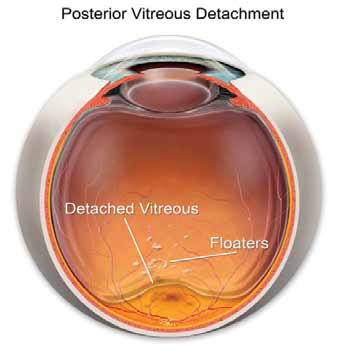Flashes & Floaters
 Most of the eye's interior is filled with vitreous, a clear, thick, gel-like substance that has the consistency of raw egg whites. As we age, the center of the vitreous slowly liquefies. The vitreous gel, with it's liquid center, eventually collapses in upon itself and pulls away from the retina. Separation of the vitreous from the retina can happen rather suddenly. When the separation occurs, the fibers inside the vitreous can become dense and visible.
Most of the eye's interior is filled with vitreous, a clear, thick, gel-like substance that has the consistency of raw egg whites. As we age, the center of the vitreous slowly liquefies. The vitreous gel, with it's liquid center, eventually collapses in upon itself and pulls away from the retina. Separation of the vitreous from the retina can happen rather suddenly. When the separation occurs, the fibers inside the vitreous can become dense and visible.
These fibers appears as "floaters", often described as black spots or cobwebs floating in one's field of vision. These floaters may also be accompanied by "flashes" of light (lightning streaks) in one's peripheral, or side vision. These flashes are caused by a pulling effect or traction that the vitreous has on the retina (the light sensitive part of the eye) as it separates from the retina. This mechanical pulling stimulates the retinal nerve cell to send an electrical signal to the brain. The brain interprets this signal as light, even though no light is there.
This entire process is called a posterior vitreous detachment (PVD). In most cases, a PVD is harmless and requires no treatment. A posterior vitreous detachment is a common condition that can affect people of any age, but usually affects people over age 50. People who are nearsighted are also at increased risk for a posterior vitreous detachment.
People who have a vitreous detachment in one eye are also likely to develop one in the other eye, although it may not happen until years later. In most cases, people do not notice vitreous detachment when it occurs or merely find it a minor annoyance because of the increase in floaters.
Although a vitreous detachment does not usually threaten one's sight, occasionally, some of the vitreous fibers pull so hard on the retina that they create a tear in the retina. A retinal tear can then lead to a retinal detachment, which is a serious and sight-threatening condition. Retinal tears and retinal detachments should be treated promptly.
If left untreated, a detached retina can lead to permanent vision loss in the affected eye. Those who experience a sudden increase in floaters or flashes of light should have an eye care professional examine their eyes as soon as possible. The only way to diagnose the cause of the problem is with a comprehensive eye examination. If a vitreous detachment has led to a retinal tear or detachment, early treatment can help prevent loss of vision.
